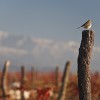In Mendoza, the principle producer of wine in the country, this is happening in the Valle de Uco. In less than a decade, this region to the south of the provincial capital, has reached 28,000 hectares, 65% more than in 2005, and the altitude limit has gone from 1,100 – 1,600 meters.
The success of this valley can be explained by the unique character of its wines, which are spoken about both here and abroad. But agronomists and winemakers are not satisfied with the results and so continue to explore every corner of the valley in search of new differentials. This fascination has already produced two regions that stand out as the first Grand Crus of the country. Gualtallary and Paraje Altamira. These two booming micro regions are proving that diversity and complexity in Argentina are not a myth. But what are the characteristics of each one?
Gualtallary, more than just altitude
This rocky, deserted corner of Tupungato has vineyards climbing up to 1,600 meters above sea level. Here, at the maximum height for cultivating grapes in Mendoza, the vines enjoy a colder climate than other areas of the province. Thanks to this, Gualtallary stands out for producing fresh, tight wines and not just Malbec but also Cabernet Franc, Pinot Noir, Chardonnay and Sauvignon Blanc.
However, the character of its wines cannot be explained by altitude alone. The key factor, is the profile of its soils: alluvial, poor, stony and with a significant presence of calcium carbonate and sand. A combo of attributes that points towards a similarity with those of Burgundy and Champagne.
This combination of cold weather and chalky soils results in intense, yet elegant wines.
“The thing that really stands out in the wines of Gualtallary is their freshness, and this is due to the acidity” explains Alejandro Vigil, chief winemaker of Catena Zapata and the person responsible for first cultivating high altitude vineyards in 1994, at 1,450m.
To this freshness we can add good structure, concentration and a unique texture. With this identikit, the wines of Gualtallary manage to impose a certain profile which in the case of Malbec, is light yet deep with an austere palate, and an elegant finish, like the 2010 harvests of Doña Paula Alluvia Parcel, Catena Zapata Adrianna Vineyard or Eggo Tinto de tiza, from Zorzal Wines.
Among the other reds to look out for is Pinot Noir, like Montesco’s Punta Negra 2013 and Rutini 2013, both subtle and enveloping. Cabernet Franc is another strong bet, and among the best is Gran Enemigo Gualtallary 2010 and Riglos Gran Cabernet Franc 2011.
As for the whites, the linear freshness these vineyards guarantee is highlighted on labels such as Sophenia Synthesis Sauvignon Blanc 2013 or Montesco Piel Sauvignon Blanc 2014. The Chardonnay is also showing huge potential.
To understand these high expectations, a good exercise is to taste two wines from Catena Zapata, bottled under the names White Stones and White Bones, both made from grapes in the same vineyard but from different parcels, where the soils have stamped each one with different nuances.
Paraje Altamira, a jigsaw puzzle of Malbec
The fact that this region has its own name is thanks to its wines and vineyards. Located at 1,100m.a.s.l, in San Carlos, to the south of the Uco Valley, it was an area within La Consulta, until recently. But the various studies of its soils and climate carried out by wineries, winemakers and agronomists, has allowed it its very own Geographical Indication: Paraje Altamira.
“Altamira lies at the heart of the alluvial cone of the river Tunuyán, and this helps us to understand the diversity of its soils,” says Sebastián Zuccardi, one of the initiators of the GI.
The part it has played has helped us to understand that over thousands of years, the water that came down off the mountain deposited various minerals and compounds in the soils of Altamira.
Today the dry river bed forms the floor of the vineyard and its heterogeneity is evident. Over a very short distance, the soil composition varies with the presence of sand, silt, stone and calcium carbonate. “The soils of Altamira are calcareous, and heavier than those of Gualtallary, so the wines are full and well rounded,” adds Alejandro Sejanovich, winemaker, soil expert and producer of Tintonegro, Zaha and Teho wines.
It is for this hidden complexity in the soils beneath the vineyards of Altamira that winemakers try out different practices and varying strains in each parcel. “Our job is plant by plant,” emphasizes Zuccardi.
By having numerous soil profiles, winemakers can identify every component and the microvinification process to understand the behaviour of each parcel of the vineyard.
Thus, from these endless options, the wines of Altamira are a kind of jigsaw puzzle that winemakers put together every year. “Achieving the expression of these vineyards is a challenge, every corner provides a profile and together they are the essence of the terroir,” concludes Sejanovich.
Today, the wines most representative of these vines, are for the most part Malbec. The icon of the region is Achaval Ferrer Finca Altamira 2011, with almost two decades under its belt. Its structured style, lightened by a lively acidity and a medium juicy palate is a good definition of what Altamira offers. In the same tune, you could try Zuccardi Aluvional 2011, Teho 2012 or the novel, Concrete 2013, Malbec from the region made in cement tanks. In all of them one can appreciate the mineral profile which stamps a chalky texture in the centre of the tongue. Alto Las Hormigas Appellation Paraje Altamira 2011 and Catena Zapata Nicasia Vineyard 2010, boast an earthy profile that adds uniqueness.
So with these two regions providing evidence of the potential for achieving unique, diverse wines, Argentina promises to continue to surprise us with unforgettable exponents from every corner of its geography.
Photo: Finca Piedra Infinita– Paraje Altamira




Pingback: Wine Up Mondays Malbec - Taste Flutter